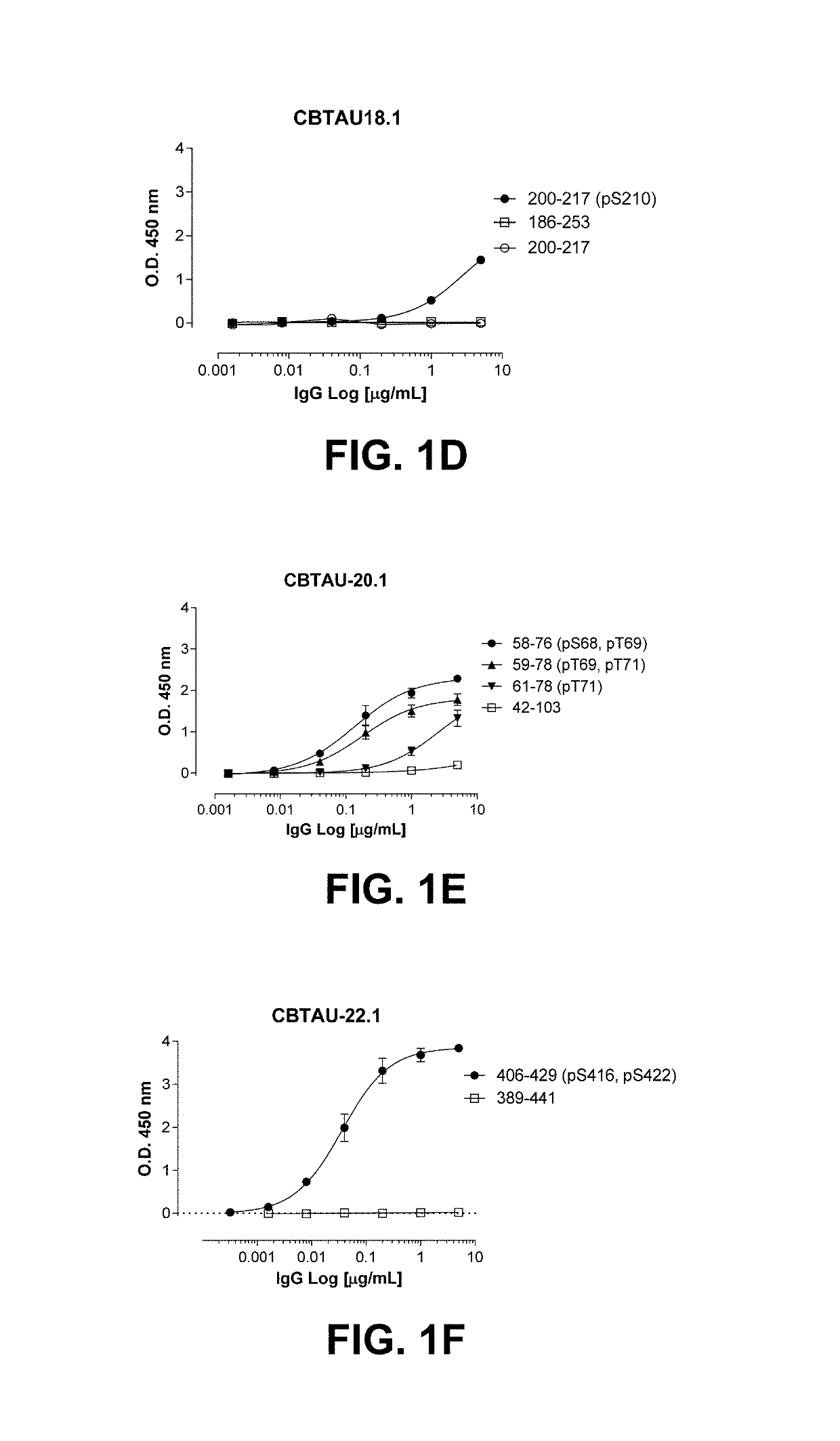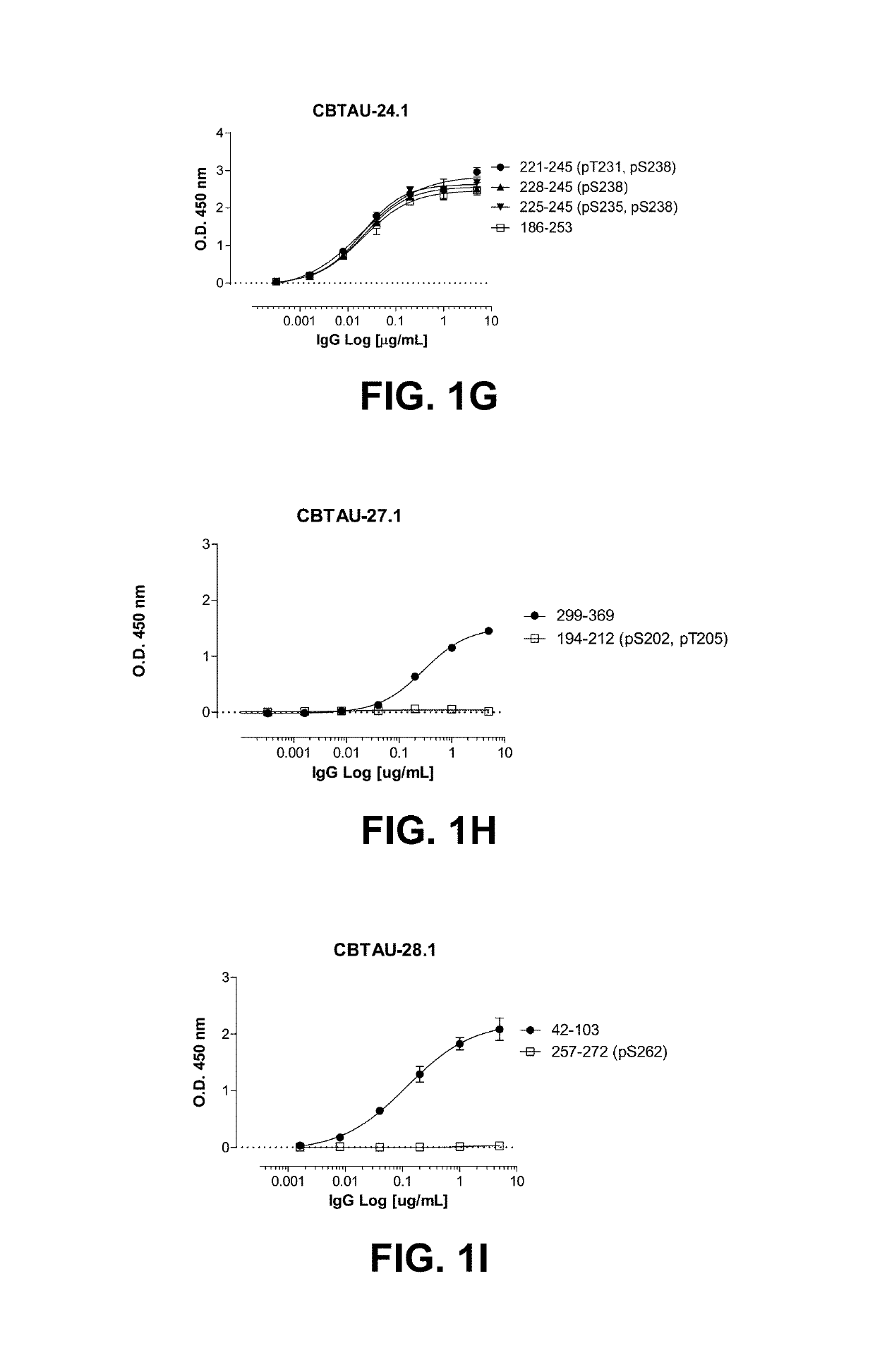Antibodies and antigen-binding fragments that specifically bind to microtubule-associated protein tau
a technology of antigen-binding fragments and microtubules, applied in the field of medicine, can solve the problems of higher opportunity costs and likely higher costs, and achieve the effect of preventing or treating a tauopathy and improving one or more symptoms of a tauopathy
- Summary
- Abstract
- Description
- Claims
- Application Information
AI Technical Summary
Benefits of technology
Problems solved by technology
Method used
Image
Examples
example 1
Tau Peptide Design and Labeling
[0122]Hyperphosphorylation of tau protein resulting in release from microtubules and leading to depolymerization is a pathological hallmark occurring in Alzheimer's disease (AD) and other related tauopathies. As the equilibrium of free tau to microtubule-bound tau shifts in favor of the former, unassociated tau protein is thought to accumulate in a misfolded, aggregated state. During the disease process, tau is thought to adopt a variety of conformations, progressing from soluble dimeric and oligomeric forms to higher-order insoluble aggregates such as paired helical filaments (PHFs) and neurofibrillary tangles (NFTs). However, the exact forms of tau that contribute to pathology and, hence, optimal for therapeutic targeting, remain unknown. Consequently, attempts to target disease-promoting tau are often limited by the choice of target. In an effort to prepare novel anti-tau binding molecules, antibody variable regions to tau were recovered from human ...
example 2
Recovery of Anti-Tau-Specific Memory B-Cells by Facs Sorting with Labelled Peptide Tetramers
[0124]Monoclonal antibodies against tau were recovered from memory B-cells (CD22+CD19+CD27+IgG+) isolated from peripheral blood mononuclear cells (PBMCs) obtained from presumably asymptomatic (non-AD) human blood donors obtained from San Diego Blood Bank and TSRI Normal Blood Donor Services. In addition, AD patient blood samples were obtained through the CRO, Quintiles, from which three antibodies detailed here were recovered. PBMCs were isolated on FICOLL-PAQUE PLUS® (GE Healthcare) and cryopreserved at 50 million cells per ml in 90% FBS and 10% DMSO. An aliquot of plasma was heat inactivated at 56° C. and stored at −20° C. for downstream assessment of plasma reactivity.
[0125]For each sorting experiment, PBMCs from three to four donors were thawed and transferred to tubes containing pre-warmed RPMI complete (RPMI, 10% heat inactivated FBS and 1% penicillin / streptomycin), washed and incubated...
example 3
Recovery of Heavy and Light Chain Genes from Tau-Specific Single B-Cells
[0126]As detailed in Example 2, memory B-cells with reactivity to tau peptide tetramers were identified, isolated and sorted into individual microtiter wells. Heavy and light chain cDNAs were then recovered by a two-step PCR approach from individual B-cells, and variable domain sequences were cloned and expressed in vitro as full-length recombinant IgG1 antibodies and are thus human chimeric antibodies.
First Strand cDNA Synthesis
[0127]First-strand complementary DNA (cDNA) was generated from single sorted cells according to manufacturer's protocol (Superscript III, Invitrogen Corp.) with the following modifications: to each well containing a single B-cell, 0.5 μl of 10% NP-40, 1.0 μl of oligo dT, 1.0 μl of dNTP was added and samples were incubated at 65° C. for 5 minutes. After incubation, samples were placed on ice for 1 minute. The following was then added to each well: 2.0 μl of DTT, 4.0 μl of MgCl2, 1.0 μl of...
PUM
| Property | Measurement | Unit |
|---|---|---|
| time | aaaaa | aaaaa |
| pH | aaaaa | aaaaa |
| volume | aaaaa | aaaaa |
Abstract
Description
Claims
Application Information
 Login to View More
Login to View More - R&D
- Intellectual Property
- Life Sciences
- Materials
- Tech Scout
- Unparalleled Data Quality
- Higher Quality Content
- 60% Fewer Hallucinations
Browse by: Latest US Patents, China's latest patents, Technical Efficacy Thesaurus, Application Domain, Technology Topic, Popular Technical Reports.
© 2025 PatSnap. All rights reserved.Legal|Privacy policy|Modern Slavery Act Transparency Statement|Sitemap|About US| Contact US: help@patsnap.com



